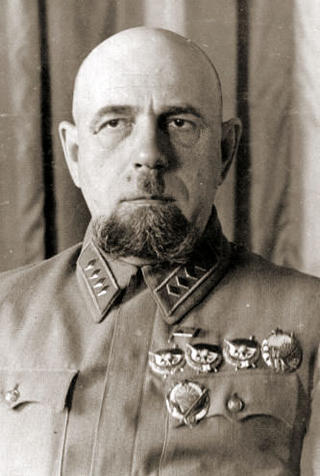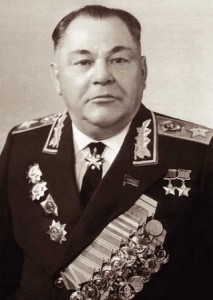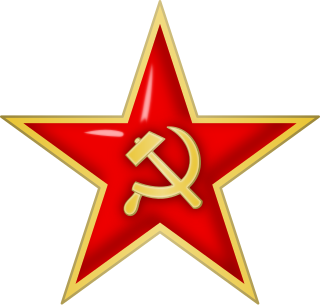Bibliography
- Civil war and military intervention in the USSR. Encyclopedia. Moscow: Soviet Encyclopedia, 1983.
The Crimean Soviet Army was a field army of the Red Army during the Russian Civil War, which existed between May 5, 1919 and July 21, 1919. It was first part of the Ukrainian Front and from June 4 of the 14th Army. On July 21, 1919 the Army was disbanded, and it was reorganised as the Crimean Rifle Division, called 58th Rifle Division from July 27.
The troops of the Crimean Soviet Army fought in the Crimea against the Armed Forces of South Russia, in the area of Polohy - Berdyansk - Melitopol in the Northern Taurida. The White Guards managed to hang on to the Kerch Peninsula, defending a front on the Aqmanai isthmus.
In May–June the Crimean Army took part in the suppression of the Grigoriev uprising.
In mid-June 1919, under the pressure of the White Army advance, the entire Red Army was forced out of the Crimea.

Pavel Efimovich Dybenko was a Bolshevik revolutionary and a leading Soviet officer and military commander. He was arrested, tortured and executed during the Great Purge and subsequently rehabilitated during the Khrushchev Thaw.

Pyotr Kirillovich Koshevoy was a Soviet military commander and a Marshal of the Soviet Union.
The 3rd Rifle Division was an infantry division of the Soviet Army. It was formed in 1921 in Crimea. The division relocated to Svobodny in the Far East during 1939 and moved to Blagoveshchensk soon after. The division fought in the Soviet invasion of Manchuria and was disbanded in 1946.
The 52nd Rifle Division was an infantry division of the Red Army during the Russian Civil War, the interwar period, World War II, and the Cold War, formed once during the Russian Civil War and three times during the existence of the Soviet Union.

The 51st Army was a field army of the Red Army that saw action against the Germans in World War II on both the southern and northern sectors of the front. The army participated in the Battle of the Kerch Peninsula between December 1941 and January 1942; it was destroyed in May 1942 with other Soviet forces when the Wehrmacht launched an operation to dislodge them from the peninsula. The army fought in the Battle of Stalingrad during the winter of 1942–43, helping to defeat German relief attempts. From late 1944 to the end of the war, the army fought in the final cutting-off of German forces in the Courland area next to the Baltic. Inactivated in 1945, the army was activated again in 1977 to secure Sakhalin and the Kuril Islands. Following the dissolution of the Soviet Union, the army continued in existence as a component of the Russian Ground Forces. The army was active during two periods from 1941 until 1997.
The Separate Coastal Army, also translated to English as Independent Coastal Army, was an army-level unit in the Red Army that fought in World War II. It was established on July 18, 1941, by the order of the Southern Front from the forces of 9th Army’s Coastal Group and was stood up on July 20, 1941.
The Crimean Socialist Soviet Republic or the Soviet Socialist Republic of the Crimea was a state allied with Soviet Russia that existed in Crimea for several months in 1919 during the Russian Civil War. It was the second Bolshevik government in Crimea and its capital was Simferopol.
The 20th Rifle Division was an infantry division of the Soviet Red Army, formed three times. The first formation of the division lasted from 1919 to 1921 and fought during the Russian Civil War before its downsizing into a brigade. The brigade became the 3rd Caucasian Rifle Division, the 3rd Caucasian Mountain Rifle Division, and the 20th Mountain Rifle Division during the interwar years. In 1944 the 20th became the 20th Rifle Division again. It was disbanded after the end of the war. The division briefly reformed between 1955 and 1957 from the 188th Rifle Division and was converted into a motor rifle division.

The Ukrainian Front, formerly the Army Group of Kursk Direction, was a Red Army group during the Russian Civil War, which existed between January and June 1919. The army group was created to invade Ukraine after the withdrawal of the Austrian-German occupation force in November 1918 and to fight the Ukrainian People's Republic, as well as the troops of the Entente which had landed on the Black Sea coast.

The siege of Perekop, also known as the Perekop-Chongar Operation, was a battle of the Southern Front in the Russian Civil War from 7 to 17 November 1920. The White movement's stronghold on the Crimean Peninsula was protected by the Chongar fortification system along the strategic Isthmus of Perekop and the Syvash, from which the Crimean Corps under General Yakov Slashchov repelled several Red Army invasion attempts in early 1920. The Southern Front of the Red Army and the Revolutionary Insurgent Army of Ukraine, under the joint command of Mikhail Frunze, launched an offensive on Crimea with an invasion force four-times larger than the defenders, the White Russian Army under the command of General Pyotr Wrangel. Despite suffering heavy losses, the Reds broke through the fortifications, and the Whites were forced into retreat southwards. Following their defeat at the siege of Perekop, the Whites evacuated from the Crimea, dissolving the Army of Wrangel and ending the Southern Front in Bolshevik victory.

Ivan Fyodorovich Fedko was a Soviet Komandarm 1st rank and army commander. He was born in what is now the Left-bank Ukraine. He fought in the Imperial Russian Army during World War I before joining the Bolsheviks. During the Russian Civil War, he fought against the White movement army of Abram Dragomirov in Kiev. He was a 4-time recipient of the Order of the Red Banner and the Order of Lenin. He was made a Komandarm 2nd rank in 1935 and a Komandarm 1st rank on February 20, 1938. In 1938, he was awarded the Jubilee Medal "XX Years of the Workers' and Peasants' Red Army".
The 271st Rifle Division was an infantry division of the Soviet Union's Red Army during World War II.
The 263rd Rifle Division was an infantry division of the Red Army during World War II.

The Kharkov Military District was a military district of the Russian Empire, the Russian Soviet Federative Socialist Republic, and the Soviet Union. Throughout its history, the district headquarters was located in the city of Kharkov in northeastern Ukraine.

The 14th Army was a field army of the Red Army during the Russian Civil War era.

The 2nd Ukrainian Soviet Army was a field army of the Red Army during the Russian Civil War, which was formed on April 15, 1919, from the units of the Group of Forces of the Kharkov Direction. It was first part of the Ukrainian Front and from April 27 of the Southern Front. On June 4, 1919, the Army was disbanded and its formations became part of the 14th Army of the Southern Front. The Army headquarters were in Yekaterinoslav.

The Evacuation of the Crimea was an event in the Russian Civil War, in which the Government of South Russia evacuated over sea from the Crimean Peninsula, the last stronghold of the White movement on the Southern Front, bringing an end to the fighting on that Front.
The 7th Ukrainian Soviet Division was a military unit of the Red Army during the Russian Civil War in the armed forces of the Ukrainian SSR.

The 1st Zadneprovskaya Ukrainian Soviet Division was a military unit of the Ukrainian Soviet Army during the Russian Civil War.
The 46th Yekaterinoslav Rifle Division was an infantry division of the Red Army during the Russian Civil War.